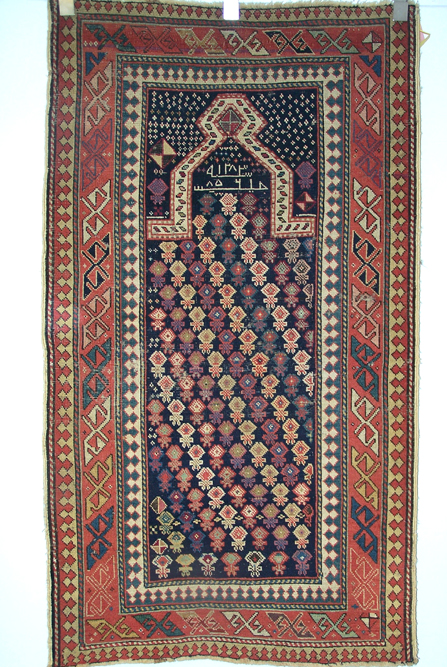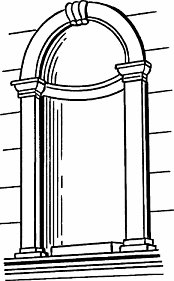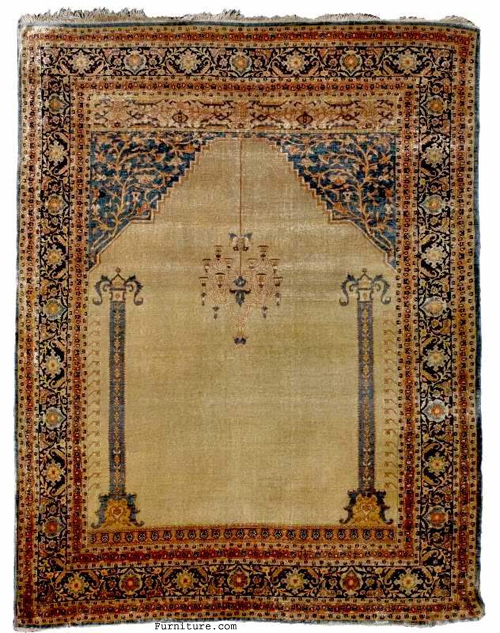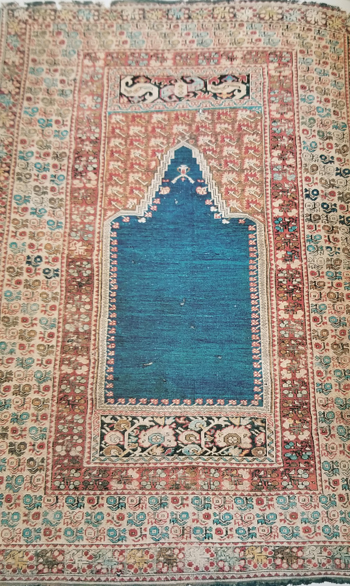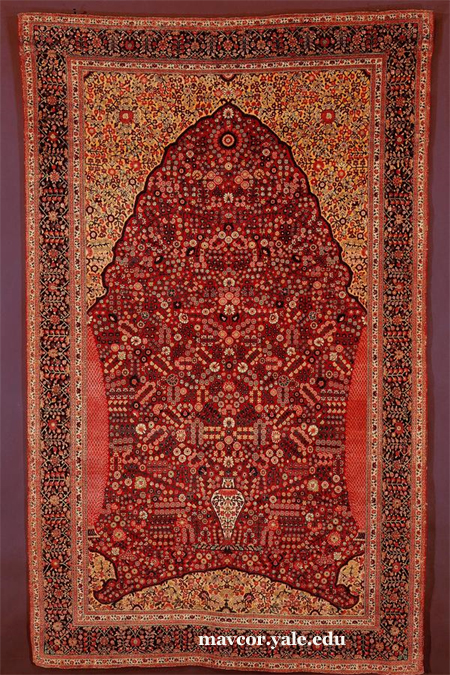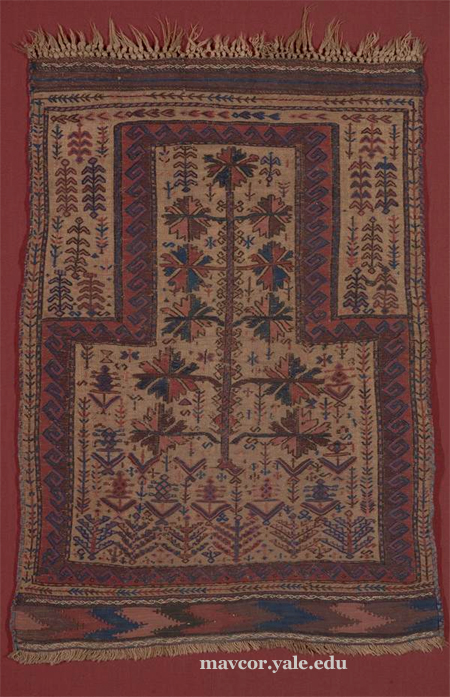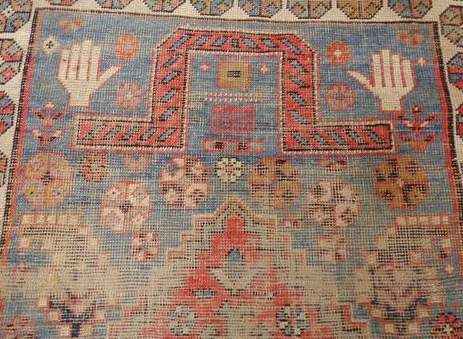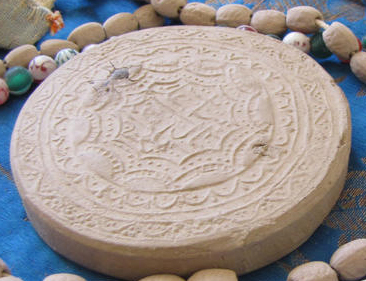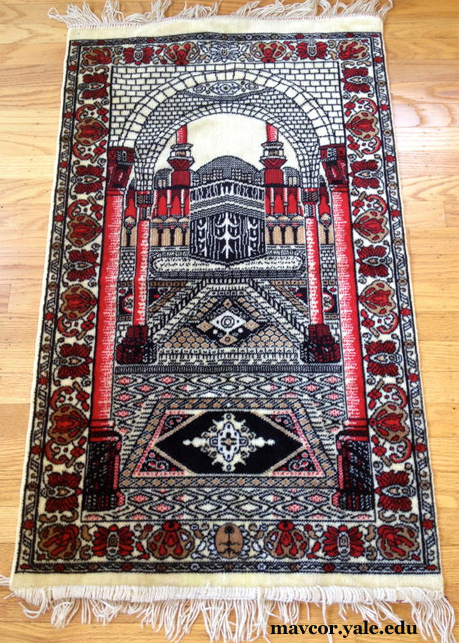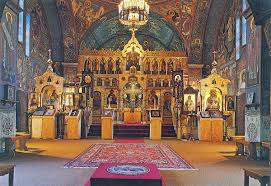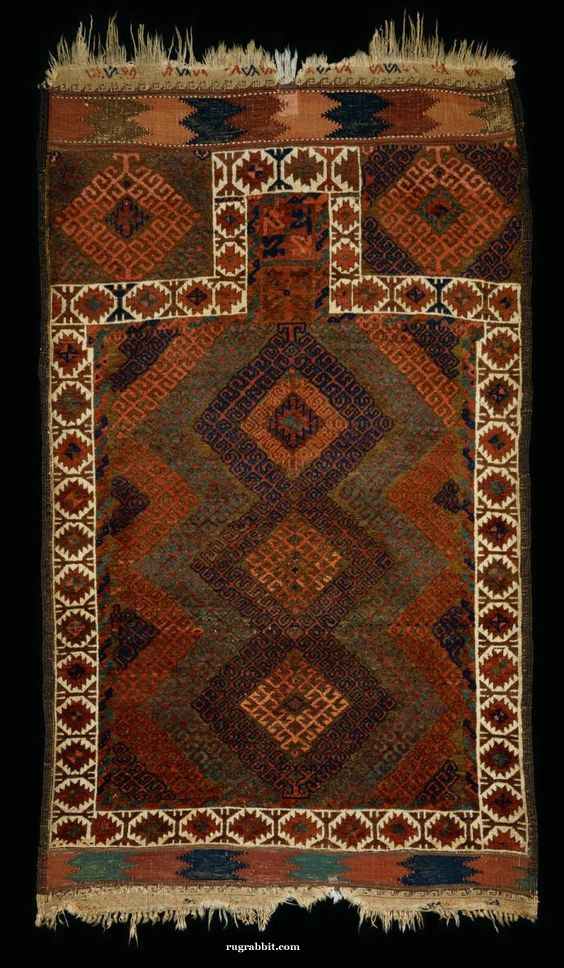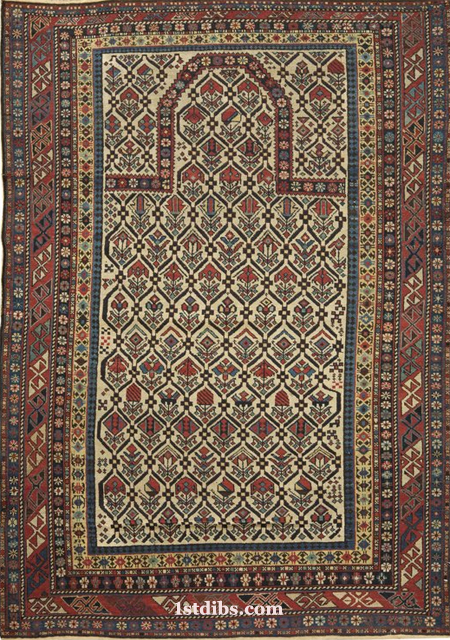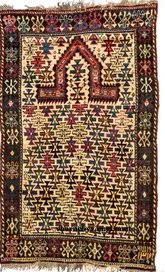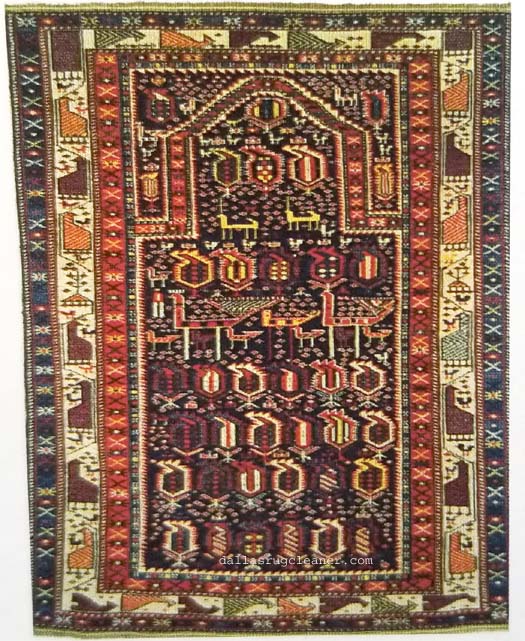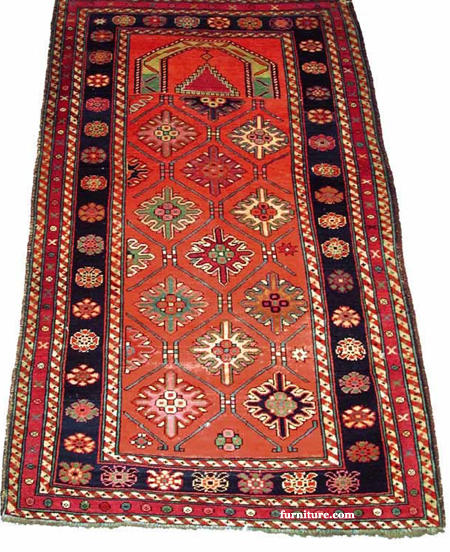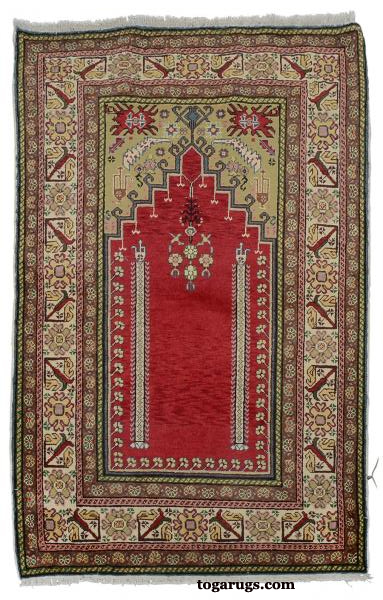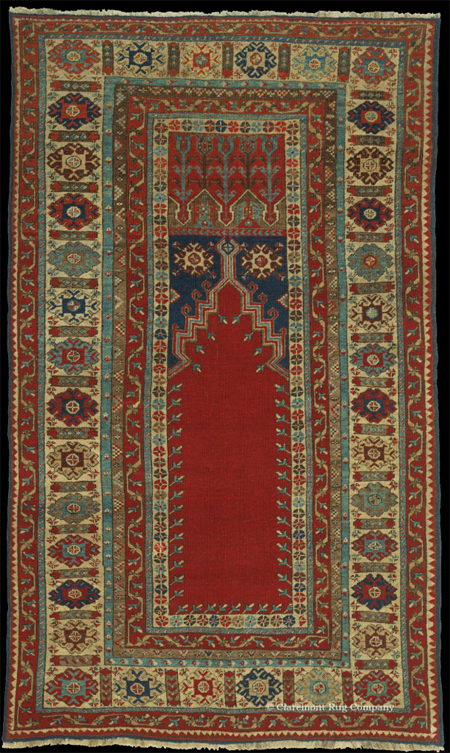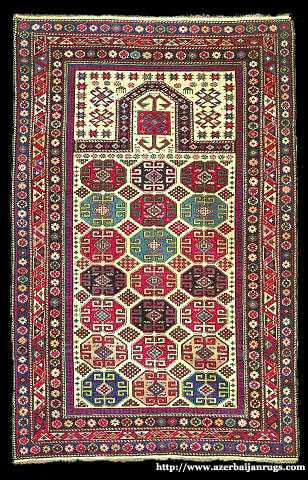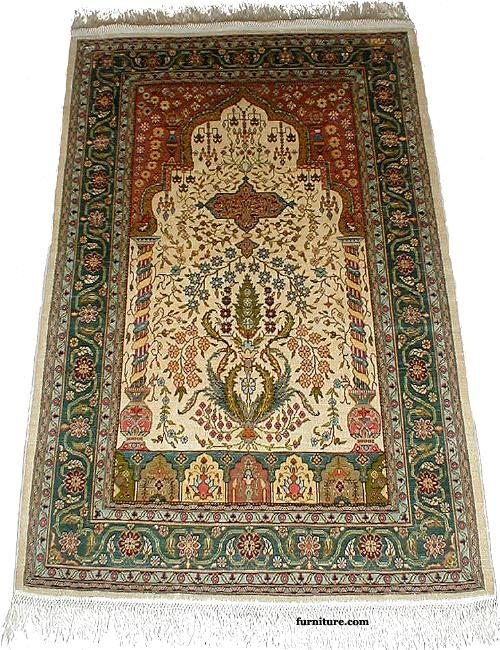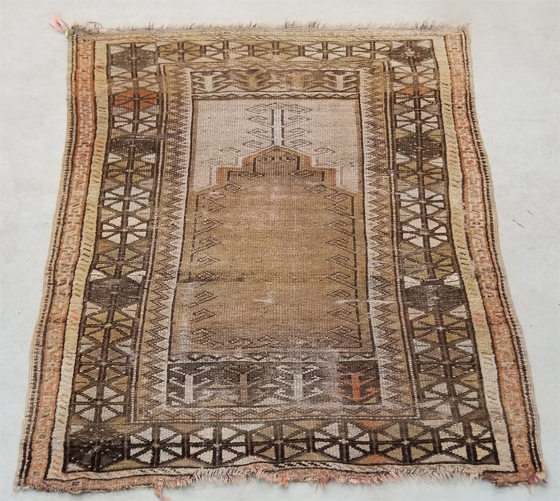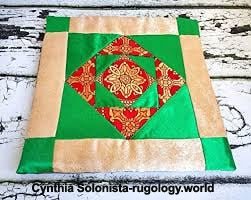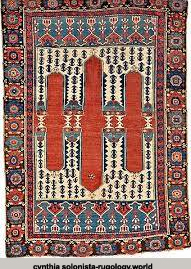PRAYER RUGS
Prayer rugs are usually described as mats to be used specifically for prayer and may be handwoven as well as machine made. (For this article, we will be concerned with handwoven prayer rugs.)
Muslims and Coptic
Christians are those most likely to use a prayer rug. These rugs are usually
very delicate and intricately woven. Many are silk, but many other materials may be
found in their construction as well. Collectors who value them use them primarily as wall
art.
The prayer rug can serve as a temporary place of worship whether in or outside a mosque or church. It is a portable sacred ground that can be used at any time, isolating worshipers from their immediate surroundings and transporting them symbolically somewhere else.
WHEN DID THE USE OF MATS OR RUGS FOR PRAYER BEGIN?
The Prophet Muhammad started the practice of using a mat for prayers. He used mats made of palm fronds. Over the next few centuries, the practice became so popular that by the 14th century travelers were reportedly carrying rugs for Salat, the ritual prayer of Muslims, performed five times daily in a set form.
Muslims lay their rugs on the ground for the Salat prayer and once done, the rugs would have to be immediately folded and put away until the next use. This helps ensure cleanliness, although cleanliness is not often an issue because the one pre-requisite for the performance of Salat is cleanliness itself!
Early Muslim leaders would have their prayer rugs customized by the greatest artists in court. The prayer rugs began to be used as a symbol of power and used as gifts as well. This practice thrived under the Ottoman, Safavid, and Mughal dynasties. These rugs became very precious and were thought of as a national treasure. They were traded and used as items of ordination.
The early prayer rugs were so precious that even though they became associated with Islam, they even found their way into Christian churches. Saxon churches, parish storerooms, and museums safeguarded about 400 Anatolian rugs, dating from the late 15th to the mid-18th century in Transylvania. They form the richest and the best-preserved body of prayer-format rugs of the Ottoman period outside Turkey. Their removal from the commercial circuit and the fact that they were used to decorate the walls, pews, and balconies, but not on the floor, was crucial for their conservation over the years.
Those early prayer rugs, created in a world that was spiritually different from Christianity and salvaged and maintained by the Reformed churches, confirms the capacity of oriental rugs to bridge different cultures as well as the traditional religious tolerance of the Transylvanians.
DESIGN OF PRAYER RUGS
The particular design of a prayer rug is and was based on the village it came from and its weaver. The rugs are usually decorated with many beautiful geometric patterns and shapes. Whatever the design, age, color, and size, a prayer rug remains one of the most cherished items in the home.
The Significance of the Mihrab (Niche)
The design of prayer rugs is characterized by a mihrab (niche or arched doorway) at one end, representing the mihrab or niche in every mosque, a directional point to direct the worshiper towards Mecca.
The niche is where a Muslim places his head during prayer. Some rugs have an actual representation of a Mihrab, while others are a bit more abstract. It is interesting that all Muslims must know the direction towards Mecca from their home or from where they are while traveling.
The Armenians have a prayer rug of their own. Being Christian, the prayer niche intended to honor Mecca is not used. However, many of the rugs are asymmetrical with a specific top and bottom. The Armenians wove their rugs as a gift to the church rather than actually use them during praying.
DESIGN OF THE MIHRAB
The mihrab design denotes Islamic architecture.
Turkish prayer rugs typically have stepped mihrabs. In Anatolia (Turkey), the doorway of the niche is a more complex architectural structure with triple arches and a higher central unit supported by paired columns. This type of structure most likely was inspired by Roman architecture.
Persians have softer, more curvilinear mihrab designs. In Persian prayer rugs the arch is usually supported by two columns, in which foliage rooted in the ground connects symbolically to the sky.
Mihrabs in Caucasian and Turkoman rugs have more geometric, rectilinear designs.
In general, the nomads use a sharp point, and the city weavers weave an elaborate domelike shape.
Caucasian rugs were produced by nomads who lived in tents in desert regions. The absence of architecture in their visual repertoire led to the production of carpets with more abstract motifs. They feature geometric, stylized arch shapes, combined with the position of the worshipers’ hands.
Some rugs have a mihrab at both ends, which is defined as a double prayer design. This design is occasionally seen in Persian rugs and in older antique Caucasian rugs but is more common in Turkish prayer rugs.
Decoration of the Space Inside the Mihrab (Niche)
The decoration of the space inside the niche varies according to the region.
In Persian carpets the niche’s interior portrays clear figurative images of the Garden of Eden, with flowers, bushes, trees, vases and birds of all kinds arranged in an abstract garden.
Other types of carpets represent a suspended mosque lamp with a floral medallion, an abstraction of the fountain, hinting at the purification ritual that precedes prayer.
In Turkish Ghiordes prayer rugs the niche interior is represented with a section in a single color featuring a void, abstracting the absoluteness of the afterlife while the border of the carpet is intricately decorated.
Flowers and Trees
Flowers and trees are often used that symbolize the abundance of nature in God’s paradise.
Tree of Life
The tree of life represents the pre-Islamic Persian mythology of eternal life. Many designs bring the tree of life and the mihrab together in the same rug.
Other Decoration
Decorations not only play a role in imagery but serve the worshiper as aids to memory. Some of the examples include a comb and pitcher, which is a reminder for Muslims to wash their hands and for men to comb their hair before performing prayer.
Another important use for decorations is to aid newly converted Muslims by stitching decorative hands on the prayer rug where the hands should be placed when performing prayer. It appears that all designs are permissible as long as they do not distract the worshiper nor disrespect Islamic values.
Borders
The borders of prayer rugs are exceptionally detailed with patterns of all sorts. Similar to the borders of Persian and oriental rugs, prayer rug borders are just as beautiful.
Prayer rugs are sometimes even decorated with images. These images are usually important Islamic landmarks, such as the Kaaba, but they are never animate objects. This is because the drawing of animate objects on Islamic prayer mats is forbidden.
Sizes of Prayer Rugs
Typical prayer rugs are rectangular and range from 2.5 feet x 4 feet to 4 feet x 6 feet, ideally just enough for a person to kneel for prostration.
NOTE: SHIITE MUSLIMS DO NOT USE RUGS FOR PRAYER!
It must be noted that not all sects of Muslims use rugs for prayer. Shiite Muslims usually pray on a clay disk called a ‘turb’ in Arabic and ‘mohr’ in Persian made from clay brought from Mecca. They may often place the disk on top of a rug.
There is a reason the Shiites use the disk rather than an actual prayer even though they do prostrate their foreheads on the floor during prayer. They prefer to have their forehead be in contact with an organic material rather than the synthetic fibers of a rug. They may also place any natural material such as a straw mat where they pray.
PRAYER RUGS TODAY
There have been a few major changes in prayer rugs over the years.
- First, they have transitioned from wool to cotton and silk as the raw material. This makes them cheaper to produce but much more accessible too. Many modern prayer rugs are strictly commercial pieces made in large numbers to sell on an international market or tourist trade.
- Another change has been in the usage of prayer rugs. Today, the use of a rug for prayer has increased and its usage as an item for décor has decreased.
- Prayer rugs today have become totally associated with the Islamic religion. The connection to other religious groups has faded.
One thing that hasn’t changed is the regard these rugs are held in by Muslims. These rugs are one of the most revered Muslim household items.
MATERIALS USED FOR PRAYER RUGS TODAY
Most mosques have rugs made of palm which is mainly symbolic because Muhammed originally used them.
The underlay for prayer rugs is a very important factor. Most weavers use a soft foam underlay. This helps in keeping the Muslim who is worshiping comfortable and also protects the rug from wear and tear.
Today, prayer rugs are being created to cater to the health needs of worshipers as well. For example, there are multi-layered rugs aimed at absorbing weight, thus reducing the pressure on the worshiper’s body. One example has five layers of which the 3 in the middle absorb pressure with the bottom layer preventing slipping and the top layer inhibiting heat and microbes.
THE SIGNIFICANCE OF THE USE OF THE PRAYER RUG
As can be seen from the information presented above, prayer rugs were and are made over a vast area and display a variety of ethnic, social, and personal expression. They illustrate the great range of creativity and expression that is found in this genre.
The prayer rug responds to one of the fundamental needs of human beings. That is the act of enclosing, defining, and giving form to the living space. It serves as protection against limitless space and time. It is a place that is both house and temple, a place of shelter and leisure, and a place for prayer.
Please note: A portion of the information for this article was used with permission of Cynthia Salonista at Rugology.world.
"The Cleanest Clean You've Ever Seen."
by
ABC Oriental Rug & Carpet Cleaning Co.
130 Cecil Malone Drive Ithaca, NY 14850
607-272-1566
